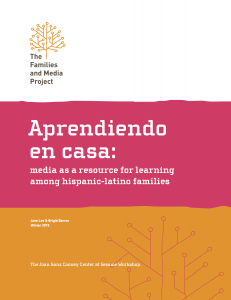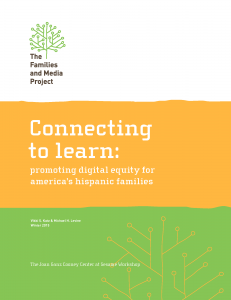The Joan Ganz Cooney Center has always been interested in how children—especially those who are struggling—learn across both formal and informal environments, whether they are interacting with media on their own or together with teachers, family members, or their peers.
In June 2012 we deepened our commitment to learning more about one of the fastest growing populations of children in the U.S. when we co-hosted a forum with our partners at the National Center for Family Literacy and the National Council of La Raza. The convening brought together some of our nation’s best researchers, innovators, thought leaders, and educators dedicated to the vital topic of how Hispanic-Latino families are learning from the rapidly changing innovations in information communications technologies. Sarah Vaala authored a synthesis of the day’s discussions and contextualizes the conversations that took place about the critical need to redefine literacy to include digital media, and the possibilities that emerge when scholars incorporate innovative methodologies into their research.
The Aprendiendo Juntos Council (AJC) was formed after this initial meeting. This multi-sector group of researchers, practitioners, and policy experts seeks to identify new models and practical strategies to improve educational outcomes for Hispanic-Latino families through the wise deployment of digital technologies. Members seek to translate cutting-edge research in order to influence public and private sector investments in programs and practices that work.
We are pleased to present three reports that are products of the AJC’s work. These publications tackle the issue of Hispanic families and digital technologies from different angles: Aprendiendo en casa reveals findings from a national survey of parents; Connecting to Learn aims to improve digital equity among low-income Hispanic families through national policies; and Digital Media and Latino Families takes a close look at the implications of this proliferation of new technologies for family and community relationships.
You will notice that each of our reports addresses the Hispanic-Latino population differently: we want to acknowledge that this incredibly large and diverse population in America does not have a single label that they prefer for themselves. Our authors have each selected the nomenclature that they were most comfortable with, and we have supported their decisions.
Aprendiendo en Casa: Media as a Learning Tool Among Hispanic-Latino Families
by June Lee and Brigid Barron

The Hispanic-Latino population is one of the largest—and most diverse—demographics in the U.S. Aprendiendo en casa reveals findings from a national survey of Hispanic parents about their home media environments and practices, and their perceptions of their children’s use of educational media across a range of different platforms. The report finds that there are significant gaps in access to computing devices and high speed Internet for children raised in English-only, bilingual and Spanish-speaking families. Families that speak primarily Spanish and which had the lowest incomes were least likely to have home Internet access or own computers, tablets, and e-readers. They were also least likely to say that their children access educational content through these technologies.
Aprendiendo en casa is based on findings from a survey that was conducted in English and Spanish with a nationally representative group of 682 Hispanic parents of children ages 2-10. The findings were derived from an analysis of the Hispanic subsample of parents that participated in a survey summarized in the Cooney Center’s Learning at Home report that was released in 2014.
The report was produced with the generous support of the Bezos Family Foundation, the Heising-Simons Foundation, AARP, and the LIFE Center.
Connecting to Learn: Promoting Digital Equity for America’s Hispanic Families
by Vikki S. Katz and Michael H. Levine

This brief combines original research and policy analysis to examine a key issue that is often overlooked in debates about the proliferation of new technologies, education, and equity: the potential for digital media investments to support a promising learning pathway for children in our nation’s increasingly diverse, low-income families.
In Connecting to Learn, Vikki Katz and Michael Levine propose an ecological approach to digital equity policy based on recent research with low-income, Hispanic families in the U.S. This brief reminds decision-makers of the importance of having an ecological understanding of the inextricable ties between learning and developmental influences at the family, community and macro-systems levels. Engaging this framework, the authors recommend solutions for building effective digital connections for all families—by leveraging low-income families’ strengths to support their meaningful digital participation.
The report was conducted with the generous support of the Bill & Melinda Gates Foundation, Bezos Family Foundation, and the Heising-Simons Foundation.
Digital Media and Latino Families: New Channels for Learning, Parenting, and Organizing
by Bruce Fuller, José Ramón Lizárraga, James H. Gray

Latino families in America increasingly enjoy access to a dizzying array of content on a variety of electronic devices, from televisions and video games to personal computers and mobile devices. In Digital Media and Latino Families, Bruce Fuller, José Ramón Lizárraga, James H. Gray raise pressing questions that face Latino families as they adopt technologies that both have the potential to entertain as well as educate. They find a new digital divide in the extent to which digital platforms are used for educational purposes by Latino children in Spanish-dominant families relative to middle-class peers. How are families engaging with this media? Who is producing digital content aimed at children and parents? How, or do, these producers consider Latino customers and clients? What kinds of devices are adults and children across this vast and diverse population using? And how are these technologies disrupting—for better or worse—family and community ties? And how can community organizations mobilize digital tools to empower children and families?
The report was undertaken by New Journalism on Latino Children, a collaborative effort with the Latino Policy Forum and Education Writers Association, and funded by the McCormick Foundation.

